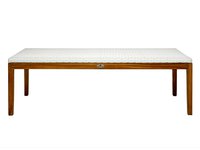Dormeuses e Panchine
Dormeuses e Panchine
Nel Settecento con il termine “dormeuse”
veniva designata una carrozzella molto
leggera in cui si poteva prendere posto anche
distesi. Questo nome passa anche ad una
poltrona con il sedile allungato destinata al
riposo diurno e a diversa altezza.
Le dormeuse si inserivano nella grande
varietà di sedute create in questo secolo che
esaltava la comodità e la vanità femminile.
Sedendosi, infatti permettevano alle signore
di dispiegare al meglio le ricche ed ampie
gonne che indossavano.
La panca è stata invece la seduta più diffusa
già a partire dal Medioevo insieme agli sgabelli
ed ai “banchi”, panche molto allungate fornite
spesso di schienale. Per tutta l’età gotica e
anche durante il Rinascimento le panche
erano i sedili preferiti per banchetti e riunioni;
alcuni modelli erano forniti di braccioli e
schienale. A partire dal Seicento anche il
sedile delle panche viene imbottito e le
dimensioni si riducono per ospitare due o una
sola persona. Anche la loro diffusione si
riduce a favore di sedie e poltrone.
Dormeuses & Benches
In the 18th century the name “dormeuse”
referred to an extremely light carriage where
it was even possible lie. The name came
subsequently to mean an armchair with a
long seat that was used for daytime rest.
There were various models that differed in
terms of the height of the back. Dormeuse
chairs fitted in perfectly well amidst the
variety of chairs which were created in that
century. They placed emphasis on comfort
and feminine vanity. In fact when ladies sat
on these chairs there was plenty of room for
their voluminous skirts.
Benches, along with stools and pews (long
benches that have a backrest), have been the
most common seat since the Middle Ages,
instead. Throughout the Gothic period and
the Renaissance benches were the favored
seat for feasts and meetings. Some models
had armrests and backs. In the 17th century,
bench seats started to be upholstered and
became smaller, holding only one or two
people. They lost ground to chairs and
armchairs.







